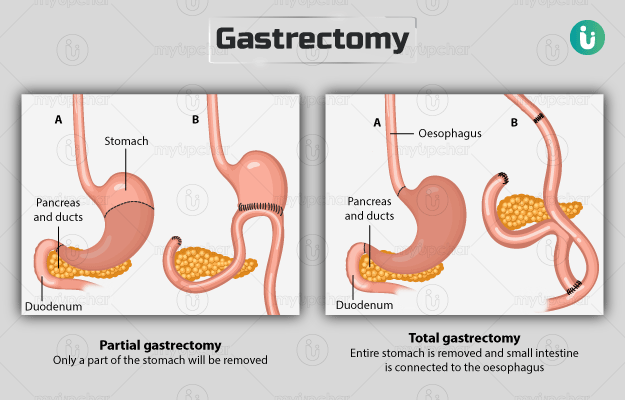Once you are admitted in the hospital, you will be asked to change into a hospital gown and wear compression stockings to prevent blood clots in your legs. You will then be taken to the operating room where an intravenous (IV) line will be placed in your arm. You will be given general anaesthesia, a medication to put you into sleep. The doctor will also insert:
- A nasogastric tube into your stomach through your nose to empty your stomach.
- A urinary catheter into your bladder to drain urine.
- A breathing tube inside your lungs through your mouth.
Gastrectomy may be performed by either of these methods:
- Open surgery: The surgeon will make a large cut on your abdomen to perform the surgery and close the abdomen with stitches or staples after the surgery.
- Laparoscopic surgery: The surgeon will make multiple tiny cuts on your abdomen. Through one of the cuts he/she will insert a laparoscope (a fibre-optic instrument). The laparoscope will let the surgeon view the inside of your abdomen on a screen. Using the images on the screen, the surgeon will then insert surgical tools through the other cuts and perform the procedure.
The types of gastrectomy are as follows:
- Total gastrectomy: During this procedure, the surgeon will remove your entire stomach and connect your small intestine to your oesophagus. They may additionally remove your lymph nodes and adjacent tissues if the surgery is done for cancer.
- Subtotal or partial gastrectomy: Here, only a part of your stomach will be removed. It is generally the lower part. Just like total gastrectomy, the lymph nodes and nearby tissues will also be removed if the surgery is being done for stomach cancer treatment.
- Oesophagogastrectomy: In this method, the surgeon will remove part of your oesophagus along with the upper part of your stomach.
- Sleeve gastrectomy: This is performed for the treatment of obesity to help with weight loss. In this, the left part of the stomach is removed.
The surgeon will chose the procedure based on the condition that needs to be treated.
Are you also troubled by obesity and are not able to lose weight even after a lot of efforts, then start using myUpchar Ayurveda Medarodh Weight Control Tablet today and control your weight.
Open gastrectomy is done as follows:
- The surgeon will make an incision (cut) from the upper mid-region of your abdomen to your navel to expose your stomach and other internal organs.
- In case of cancer, the surgeon will examine the adjacent organs like the liver and intestines to see if cancer has spread.
- He/she will then tie up the arteries in the surgical area and move them out away to prevent excessive blood loss.
- Next, the surgeon will remove the affected portion or whole of your stomach based on the type of procedure.
- The surrounding lymph nodes will also be examined to check if the disease has spread to them, in which case they will be removed.
- Finally, the surgeon will rejoin the cut end of the stomach to the ends of the duodenum, and close the cut with stitches.
- He/she will place a drain inside your abdomen to remove any accumulated fluid.
The procedure for a laparoscopic gastrectomy is similar.
Sleeve gastrectomy is generally performed laparoscopically. In this surgery, the surgeon uses continuous staples to cut off a longitudinal section of the stomach. The remaining stomach is now banana-shaped and is about 20% to 25% of its original size.
Gatrectomy usually goes on for one to three hours.
After the operation, you will be under observation for a while in the intensive care unit. You will be given an oxygen mask after the surgery, which you may need for some days. Once you are completely awake, you will be taken to the recovery room where your vital signs will be monitored, and you will be provided nutrition by an IV drip.
You will be on pain medication as required and will not be able to drink or eat for about five days. A special X-ray will then be taken to assess your recovery, and then the doctors will decide if you can start consuming liquids and progress to solid food.
The drains, tubes, and catheter will be removed in seven to 10 days. The stitches will also be removed after seven to ten days.
You will be given a discharge when you can move about comfortably and the doctor is satisfied with your recovery; this typically takes about two to three weeks.
















